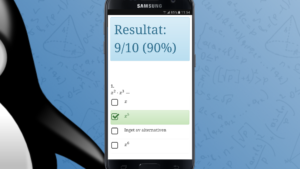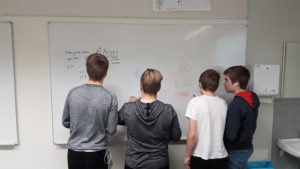It has now been over three months since me and my students have worked together. During this period their mathematical skills have improved drastically. If the students would realize this for themselves, this would greatly improve their confidence in their abilities. So in order to accomplish this I used a test, but not in a standard way.
What I did was that I tested my students the very first lesson which we had in August. The test consisted of quite simple tasks, which I know can be difficult for students starting junior-high. However, they never got to see their results. Instead I waited to hand out the tests until I was sure that all the students would have made enough progress in mathematics to be able to correct their own mistakes. This way they could easily see how much they have learned.
 When the tests were handed out three months later, basically everyone was able to correct it. The students enjoyed seeing how much they had improved, but in contrast to my own belief, I do not think that seeing the test results helped the students realize how much progress they had made. This is because of one simple reason; they were already aware of how much progress they are making. Focusing on improving strategies for learning has made the students aware of what to do and what not to do in order to learn, and here is how i know this:
When the tests were handed out three months later, basically everyone was able to correct it. The students enjoyed seeing how much they had improved, but in contrast to my own belief, I do not think that seeing the test results helped the students realize how much progress they had made. This is because of one simple reason; they were already aware of how much progress they are making. Focusing on improving strategies for learning has made the students aware of what to do and what not to do in order to learn, and here is how i know this:
After the students had corrected their test, I gave them the following three questions.
- What are the things which have helped you to learn mathematics?
- What are the things which you have done well, or learned how to do well, in order to learn mathematics?
- What are the areas where you still have to improve in order to learn even better?
Every question was to be given three answers in order to make the students think about what they are doing right and what they have yet to improve, to be able to learn even better in the future.
I was honestly surprised by how aware thirteen years old can be of their own learning. Many students wrote about how they have learned to discuss mathematics with their friends and family, and how being organized and drawing pictures can help to solve more difficult problems. They also had very detailed ideas on what they have yet to improve.
Next I will share the top three things, which they said has helped them to learn mathematics, since these are hopefully interesting for all teachers.
Number three; Digital tests
 We are using a digital math book which consists of many digital tests. These tests provide the teacher and the students with frequent results on how well the students have learned the content. These tests have always been popular among students, and this year was no different.
We are using a digital math book which consists of many digital tests. These tests provide the teacher and the students with frequent results on how well the students have learned the content. These tests have always been popular among students, and this year was no different.
Click here to read more about these tests.
Number two; Working on whiteboards
 I have filled my classroom walls with whiteboards for the students to work on, and there are many benefits when working on them. As a teacher you can easily get an overview of all students work, and this is handy when working on new types of exercises especially. Many students also prefer to work together on the whiteboards when they are collaborating on difficult problems.
I have filled my classroom walls with whiteboards for the students to work on, and there are many benefits when working on them. As a teacher you can easily get an overview of all students work, and this is handy when working on new types of exercises especially. Many students also prefer to work together on the whiteboards when they are collaborating on difficult problems.
Click here to read more about working on whiteboards.
Number one; Reading the theory
 I was honestly surprised by how many students said that reading the theory help them to learn. Approximately 40 percent of the students mentioned this. Reading and understanding mathematical theory require practice, and this is something we have been working on since day one.
I was honestly surprised by how many students said that reading the theory help them to learn. Approximately 40 percent of the students mentioned this. Reading and understanding mathematical theory require practice, and this is something we have been working on since day one.
In our digital math book the new theory that is needed to solve problems is only one click away for the students.
My students in grade seven have worked hard and they have made incredible progress in developing strategies for learning. Each day they are improving their skills which are needed to learn, and this is resulting in a faster learning curve. I am convinced that by focusing on strategies to learn, students will achieve great results in mathematics, but this is not all. Mastering the ability to learn will help you accomplish anything.
Would you like to learn more about the digital math book which we are using? Then please visit Ma.fi (available in English, Swedish and Finnish).